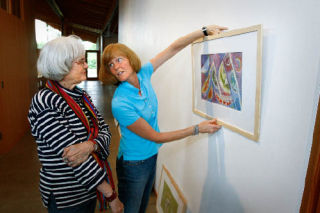Berit Ringo drew a self-portrait in subdued charcoal, because, she said, that’s the way it’s usually done.
Everything else hanging in her show of monotypes at Grace Episcopal Church sings out in living color.
“I seek to celebrate life and hope,” Ringo says in her artist statement, “and am continually drawn to vivid, warm colors to affirm both – life and hope.”
A native of Oslo, Norway, Ringo calls her art background “somewhat hit and miss,” with classes and workshops for years having merely punctuated her busy daily life.
Fifteen years ago, art classes began to play a more consistent role, particularly when she began studying monotype under Joan Stewart Ross at North Seattle Community College.
More recently, Ringo’s husband passed away, leading a shift in artistic focus.
Questions of identity had arisen. Ringo was an immigrant in 1948 when she arrived at Midland College in Fremont, Neb., where she met the man she’d marry. He’d go on to become a Lutheran minister, she an elementary school teacher. They settled in Seattle and raised four children together.
Who was she, now that he’d gone? And where was he?
“You live in a couple world, and you don’t anymore,” she said.
Ringo took some comfort in continuing her art classes in the company of other people, and six months ago began a new series of monotypes that explored personal and global themes like home, identity, journey, faith, transformation and connections. Her son, Tom, a parishioner at Grace, suggested that the church gallery’s walls might lend themselves to her work.
Her collection, at Grace through August, carries out Ringo’s themes in gracefully composed, highly graphical motifs that convey both weight and welcome, seriousness and delight, adult perspective rendered with childlike boldness.
They include masks, leaves, houses, crosses, fingerprints – a marker of identity if ever there was one – boats and children. With few exceptions, the work is depicted in bright, melony pastels: peaches, yellows, greens, and pinks. They all make rich use of the monotype form; after printing an oil painting, Ringo works over the image with more paint and collage.
In a file drawer, Ringo’s husband had left behind 40 years of sermon outlines, “hundreds and hundreds,” all hand-written in a careful, elegant script. These became the artist’s primary collage element, enabling her to “ponder the connections between text and identity” and to preserve her husband’s memory.
“That’s helpful, to put them to some kind of use, so that they get a new function,” she said. “If he isn’t here, he’s part of the picture.”
Many of Ringo’s images make direct visual and literary references. The crosses are based on a church in Seattle’s Ballard neighborhood. The masks were inspired by “Till We Have Faces,” C.S. Lewis’ reworking of the myth of Cupid and Psyche.
“Nora and Her Sisters” shows eight girls arranged head-to-head in a tightly packed line, like the paper doll cutouts Ringo made as a child. This exploration of feminism was inspired by Norwegian playwright Henrik Ibsen’s “A Doll’s House.”
Ringo likens her work “to a little journal,” an exploration of the big and small questions we each unavoidably encounter, and the power of art to move suffering toward optimism.
“I couldn’t stand to do all the sad stuff,” she said. “It’s like whistling in the dark.”
========
Whistling in the dark
Berit Ringo’s monotypes are on view through August at the Gallery at Grace, 8595 Day Rd., with an artist reception from 10:30 a.m. to noon July 13. For more information, call 842-9997.



